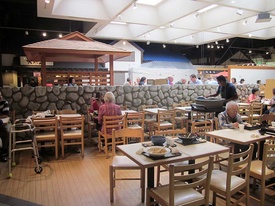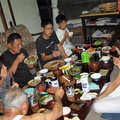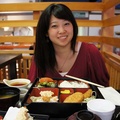Read part 1 >>
The Atmosphere: People, Spatiality, and Food
There are several entrances to this particular Mitsuwa Marketplace. The biggest entrance, however, is on the north end and shoppers who enter there are forced to walk through Restaurant Row to get into the grocery store. Although the appearance and décor of Restaurant Row varies by location, the one in Torrance is exceptionally different. All of the independent restaurants, with their individual traditional Japanese-styled roofs, give off the feeling of walking down an alleyway in the middle of some historical Japanese town such as Kyoto. The seating is also interesting to note. The center of the court is elevated with parts of it fenced and parts of it decorated with a rocky-wall, essentially creating an outdoor vibe indoors. Perhaps unique to this Mitsuwa, there is also a separate, secluded porch-like structure with tatami seating in which diners are asked to remove their shoes and sit as one would in a traditional Japanese house.1
These highly visible signs of culture transform this place from an American suburban food court into an authentic, traditional Japanese-style outdoor atmosphere, making diners feel as if they have been transported through time and space simultaneously. In this atmosphere, one can imagine eating ramen in a small town in Hokkaido, perhaps where Mr. Hatanaka first began his franchise, rather than in a typical food court inside an American mall.
In looking at the clientele, one can tell that this transformation of space is inviting to both Nikkei and non-Nikkei as well. When I went on a Saturday around 2:00PM, the majority of the clientele in Restaurant Row was Japanese families. Two tables away from myself sat a pregnant lady and her husband with their toddler child wearing a green frog bib. On the other side of me were two small children running around, giggling as they waited for their grandmother to catch up to them. Then an elderly couple came in, an old man with his cane and his wife who went to get his big bowl of ramen. Aside from the families, I also noticed a young couple taking mental notes of the food available to them after going shopping. “They have sandwiches here. Maybe I want that today,” she said in Japanese as they continued their walk into the marketplace.
I know from personal experience that weekends are the busiest days for these ethnic grocery stores. At the location that I frequented in San Jose, there was always a fight for parking, and waiting for “your turn” to choose the freshest vegetables was a given. This crowded nature was also apparent in the food court as well. Even at the odd time of 2:00PM-4:00PM where it is neither lunchtime nor dinnertime, there were still many people eating in Restaurant Row. This made me curious as to whom else besides families frequents these restaurants on weekends.
According to the cashier at Miyabi-Tei, weekday lunchtimes are busy for them because businessmen from the nearby offices come in for a quick taste of Japan.2 The Santouka cashier also told me, “Sometimes I see the hotel card key in the customer’s wallet and I think ‘oh so you’re here on a business trip and staying in that hotel across the street, huh?” reflecting the other customers at Restaurant Row. Interestingly, the preferences for these businessmen’s lunches vary by ethnicity. The Miyabi-Tei’s cashier told me, “The Nikkei businessmen like to order the teishoku whereas the white folks like curry.” Perhaps the obento teishoku are more palatable for the Japanese who want to enjoy different flavors and textures of their homeland in a single meal.
This was certainly the case for me. Nearing 6:00PM and after having watched other customers eat all day, I was yearning for a good meal. I ordered a mackerel teishoku from Miyabi-Tei to fulfill my craving for my favorite fish. In Japan, fish, whether it is cooked or raw, is an indispensible part of their diet. Japanese kitchens, instead of having large ovens like in America, are often equipped with a fish-grill installed under their stoves. One could say that the Japanese love their fish as much as Americans love their baked goods. Along with my large piece of mackerel and cabbage, there were other side dishes—a big bowl of rice, miso soup, a slice of cold tofu, and three pieces of Japanese pickles that made this one of the most complete Japanese meals I have had in a very long time. Each grain of white rice fluffed to perfection, the slight bitterness of the miso soup, and the juicy grilled fish reminded me of my mom’s cooking, something I have not been able to eat in a few months. This meal took me home.
It’s no surprise why Mitsuwa Marketplace in Torrance has great reviews.3 Not only is it fast and easy, it is also decently priced. With my obento combination at seven dollars and ramen at Santouka around 12 dollars for a set, Restaurant Row offers a good deal even compared to Japanese standards. Even though it is placed in the middle of an ethnic grocery store in a rising Japanese ethnoburb and thus highly catering to the Nikkei community, Mitsuwa’s Restaurant Row also meets the needs of the rest of their American clientele by providing bilingual menus and staff. It is evident that this ethnic supermarket, by creating a space for the consumption of Japanese food culture outside of Japan, is marketing to the Nikkei who desire a taste of their homeland and also to other Americans seeking a journey into Japan without leaving the American suburb of Torrance.
Conclusion: Transnational Time & Space Warp
In this essay, I have attempted to illustrate how the rise of Japanese markets such as Mitsuwa is a reflection of the growing Japanese diaspora in the United States, focusing particularly on the two restaurants Miyabi-Tei and Santouka within a food court called Restaurant Row. Japanese immigrants, their Nikkei offspring, as well as visiting businessmen are able to enjoy the flavors, smells, and sights of their homeland through the various foods and atmosphere of Restaurant Row. These ethnic niches as public sites however, and are not just limited to the Nikkei community but are accessible to others as well. As Mankekar argues, these are “important sites for the production” of a Japanese culture outside of Japan. They challenge the traditional relationship between a culture and bounded national territory by reproducing a facet of Japan and thereby redefining the confines of “Japaneseness.” Japanese markets such as Mitsuwa project onto an American suburb a small slice of Japan to be consumed by those either craving their homeland or purely interested in its culture. They are, in essence, hotspots of transnational activity.
Perhaps the New Jersey Mitsuwa website says it best. “Once inside the shopping center, you think you are transported to Tokyo! This Japanese superstore will bring you to the heart of Japan when you see our vast selection of Japanese grocery, succulent sashimi & sushi, premium sake to scrumptious Japanese cuisines in the Restaurant Row.”4 Thanks to supermarkets like Mitsuwa, we no longer have to travel thousands of miles and empty our wallets to experience Japan. For those close enough to such a supermarket, Japan may be just a matter of minutes away.
Notes:
1. In Japan, there are many Japanese styled bars called Izakayas that ask you to remove your shoes and sit on the floor. Women are not supposed to sit “Indian-style” in these types of restaurants.
2. This may possibly be a direct challenge Krishnendu Ray’s contention that dinner is the time of day for ethnic traditional eating habits. See Krishnendu Ray “Meals, Migration, and Modernity:Domestic Cooking and Bengali Indian Ethnicity in the United States,” Amerasia Journal Vol.24.1 (1998).105-127.
3. It received 4.5 stars out of 5 on Yelp with 254 reviews. See “Mitsuwa Marketplace” Yelp- Real People, Real Reviews, accessed March 6, 2011. http://www.yelp.com/biz/mitsuwa-marketplace-torrance
4. “New Jersey Store,” Mitsuwa Marketplace, accessed Mar. 2, 2011, http://www.mitsuwa.com/tenpo/newj/eindex.html.
Bibliography
Krishnendu Ray, “Meals, Migration, and Modernity: Domestic Cooking and Bengali Indian Ethnicity in the United States,” Amerasia Journal 24:1 (1998): 105-27.
“Mitsuwa Marketplace” Yelp- Real People, Real Reviews, accessed March 6, 2011. http://www.yelp.com/biz/mitsuwa-marketplace-torrance
“Mitsuwa Past Event Information,” Mitsuwa Marketplace, accessed Mar. 2, 2011, http://www.mitsuwa.com/eventold/eindex.php.
“New Jersey Store,” Mitsuwa Marketplace, accessed Mar. 2, 2011, http://www.mitsuwa.com/tenpo/newj/eindex.html.
Purnima Mankekar, “ ‘India Shopping’: Indian Grocery Stores and Transnational Configurations of Belonging,” The Cultural Politics of Food and Eating, pp.197-214.
“Ramen Santouka- The Birth of a Legend,” Santouka, accessed Mar. 2, 2011, http://www.santouka.co.jp/en/history/index.html.
© 2011 Eri Kameyama








